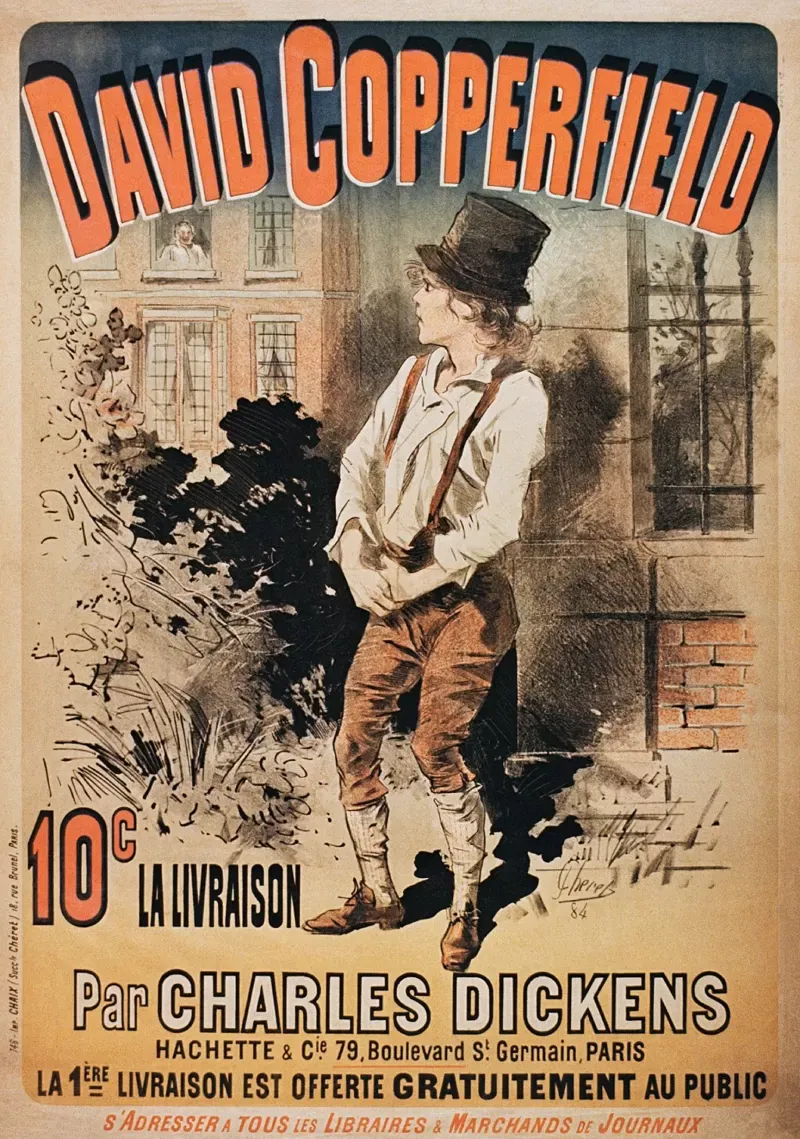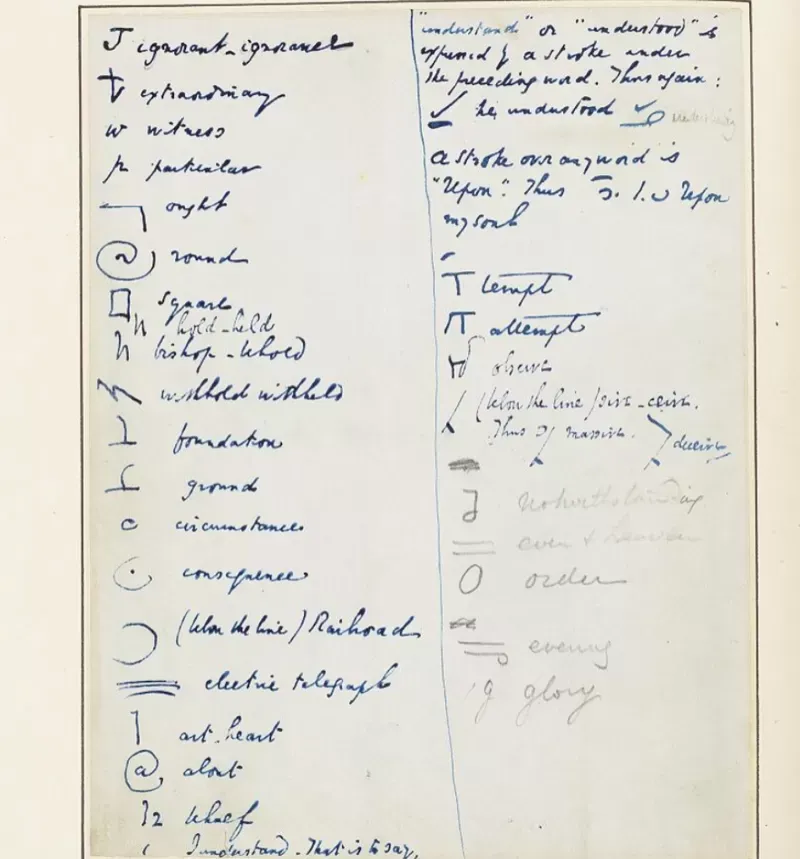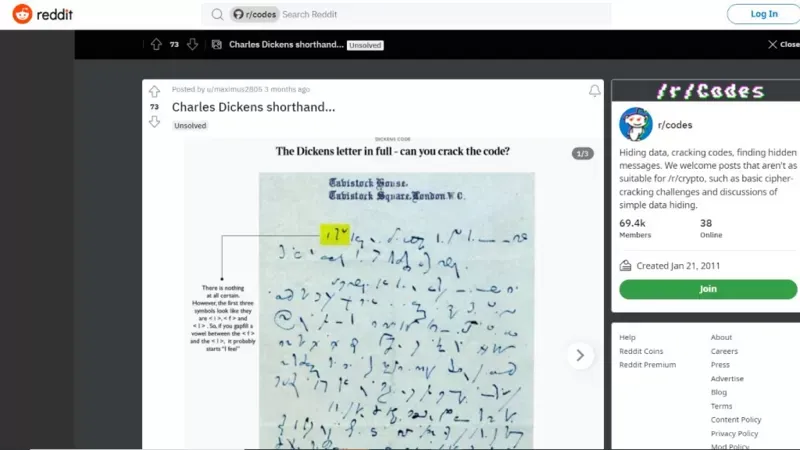Much can be said of the way of writing of the famous author British Charles Dickens, but not that he was impenetrable.
The most popular novelist of his day, he wrote for the widest possible audience, serializing his stories in newspapers before publishing them as books.
- “My boyfriend killed my son, but they sent me to jail”
- 5 scenarios of how a war between Russia and Ukraine can be avoided
- Carfentanil, the medicine to sleep elephants that was found in adulterated cocaine in Argentina
However, for more than a century and a half after his death, several of his texts have been a devilish puzzle for scholars.
He wrote them in a shorthand called “the devil’s letter” and no one has been able to read them.
That is why the Dickens Code project appealed to the public to help decipher what is known as the “Tavistock Letter,” written by the author on blue letterhead, and housed at the Morgan Library and Museum, USA. .USA
Hundreds of volunteers from the UK, Italy, North and South America, Spain and Australia helped decipher more than 60% of the text, enough for researchers to finally understand its meaning.
Why so difficult?
The hermetic texts are written in a system of shorthand called “brachygraphy” which is notoriously difficult.
Dickens described it as “a wild stenographic mystery” in his semi-autobiographical novel “David Copperfield”… and who better than that character to give you an idea of how intricate he is.
“I bought a celebrated treatise on the art of shorthand (which cost me ten shillings) and plunged into an ocean of difficulties, and after a few weeks I had been almost mad at all the changes that one of those accents could have which, placed in a random way. one way they meant one thing and another in such another position; the wonderful whims figured by indecipherable circles; the enormous consequences of a sign as big as a fly’s leg; the terrible effects of a badly placed curve, and they didn’t concern me only during my study hours: they haunted me even during my sleeping hours.
When at last I managed to find my way more or less gropingly in the midst of that labyrinth and almost mastered the alphabet, which alone was a whole temple of Egyptian hieroglyphics, I was assailed by a procession of new horrors, called arbitrary signs.
I have never seen such despotic signs; for example, they absolutely wanted a line finer than a spider’s web to mean wait, and a kind of Roman oil lamp to translate as harmful.
As I managed to get all this into my head, I realized that I had forgotten the beginning. I relearned it, and then I forgot the rest. If I tried to remember it, it was some other part of the system that eluded me.”.
(Excerpt from “David Copperfield”, serialized between 1849 and 1850, and in book form in 1850)
virtually indecipherable
Dickens submitted to such ordeal as he worked as a legal, parliamentary and news reporter between 1829 and 1834, and as such he had to capture speeches quickly, “write more with less”.
But -perhaps you are wondering- why if he used a system that, no matter how complicated it was, was known, it has not been possible to decipher his texts?
Well, on the one hand, brachygraphy is a particularly difficult system because some letters share a symbol, because certain features of the vowel encoding left to the discretion of the writer shorthand and because consonant sounds can be spelled with more than one letter, leading to inconsistencies in representation.
On top of that, the novelist personalized it, altering the shapes of the symbols and inventing their own arbitrary characters.
What’s more, it was changing over time so that the fact that one of his shorthand manuscripts has been decoded does not mean that the key to reading the others has been found.

Despite all that…
The strategy of the Dickens Code project paid off.
Kelly McCay, a Harvard shorthand expert and member of the judging panel, described shorthand cracking as “a series of flashes of light that gradually coalesce into something cohesive, and collaborating with others means a lot more enlightenment”.
“We collected the flashes from different solvers and it all fell into place,” said Hugo Bowles, a professor at the University of Foggia – which is collaborating on the project – and author of “Dickens and the Stenographic Mind.”
“One of our solvers found the words ‘Ascension Day’ and another found ‘next week,’ which helped us identify the date of the letter. Those who knew Dickens identified the abbreviation ‘HW’ as his magazine’Household Words‘ and connected the symbol for ’round’ to their ‘All the Year Round’ magazine.
Thus the puzzle was put together.
“When others came across the words ‘ad’, ‘rejected’ and ‘returned,’ we knew you were writing about an ad of yours that had been rejected. The words ‘false and unfair’ and ‘in open court’ indicated that he complained that the rejection had no legal basis”.

In context
These clues led researchers to the Morgan Library and Museum in New York, which has a letter to Dickens dated May 9, 1859 written by Mowbray Morris, manager of The Times newspaper.
In it Morris apologized to the writer for the rudeness of an employee that I had rejected an advertisement of yours because he feared its legal consequences.
The announcement that Dickens wanted to publish was clearly urgent.
May 1859 was a crucial month in the author’s publishing career: In addition to his work as a novelist, Dickens was part owner and editor of the popular Household Words magazine.
After falling out with his publishers over a dispute that arose from his separation from his wife Catherine, Dickens had decided to dissolve the partnership and establish a new magazine called All The Year Round.

To avoid losing readers of Household Words, he wrote an announcement saying he was “discontinuing” it, which was the legal term the judge in the case had required.
But The Times had a policy of rejecting any advertisement that could confuse the public and it seemed to the employee that the term “discontinue” might give the impression that it was closing it down.
The Tavistock Letter then turned out to be the shorthand copy of the letter that Dickens wrote to his friend JT Delane, the editor of The Times, asking him to intervene. So it was, and the advertisement was published as requested by the famous author.
The winner
Internet crypto enthusiasts don’t need much incentive to get to work on code that hasn’t been cracked for as long as this: the challenge is compelling enough.
But the challenge was posed as a competition, so there was a winner: Shane Baggs, an IT support specialist from San Jose, California. who had never read a Dickens novel.

He was one of the thousand people who downloaded the Tavistock Letter and transcribed more symbols than any other competitor, as well as managing to decipher some of the most complex symbols of the note.
“After getting poor grades in literature, I never dreamed that nothing I would do would be of interest to the Dickens scholars! It has been an honor working with Professor Hugo Bowles and Dr Claire Wood (project leader, University of Leicester), and I am glad to be able to contribute,” said Baggs.
* The Dickens Code project continues until February 2023. With the help of the public, the goal is to find full or partial solutions for all shorthand manuscripts that have not yet been deciphered..
RECOMMENDED VIDEO
IT MAY INTEREST YOU
- The extraordinary gene that made our brain special
- ‘They are recruited in schoolyards’: Romanian girls trafficked as sex slaves in the UK | BBC investigation
- “I was 12 years old and just a slave to them”: Romanian girls trafficked as sex slaves [VIDEO]
- How women around the world are using technology to end street harassment
- The finding that suggests that Neanderthals and modern humans lived together for 10,000 years in Europe
Source: Elcomercio

:quality(75)/cloudfront-us-east-1.images.arcpublishing.com/elcomercio/WEO2L73UX5AFNKZXLTLLOBZ6RQ.jpg)


:quality(75)/cloudfront-us-east-1.images.arcpublishing.com/elcomercio/JMT5L6IM65FOTHNWRYWVWZPZLA.jpg)
:quality(75)/cloudfront-us-east-1.images.arcpublishing.com/elcomercio/FKJKCYCUARGIJMFO7P4IOMMBXY.jpg)
:quality(75)/cloudfront-us-east-1.images.arcpublishing.com/elcomercio/OP7HLA7FA5H4NDISKLXJU4N7XM.jpg)
